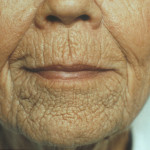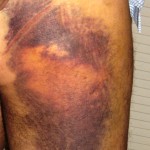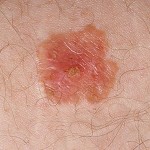The skin is the largest organ of our body. It is responsible for regulating our body temperature, protecting us from pathogens, and provides a barrier against invasion by outside organisms. The skin protects underlying tissues and organs from abrasion and other injury, and its pigments shield the body from the dangerous ultra violet rays in sunlight.

As we age, our skin, like many other things about our bodies, changes. Many older people suffer from dry skin, which feels rough and scaly. There are many causes for dry skin, some of which include:
- Not drinking enough liquids (dehydration)
- Staying out in the sun
- Being in very dry air
- Smoking
- Stress
- Losing sweat and oil glands which is common in aging
Dry skin can also be caused by health problems such as diabetes or kidney disease, using too much soap, antiperspirant, or perfume, and taking baths in water that is too hot can make dry skin worse.
Some medicines can make skin itchy. Because older people have thinner skin, scratching can cause bleeding that may lead to infection. If your skin is quite dry and itchy, talk to your doctor before it becomes infected.
Some ways to help dry, itchy skin are:
- Use a moisturizer every day. Creams offer better moisturizing effects than lotions, but lotions tend to be absorbed more quickly and be less messy.
- Take fewer baths and use a mild soap. Warm water is less drying than hot water.
- Try using a humidifier in your home, especially in the cold winter months when the furnace is on. A humidifier is an appliance that adds moisture to the air.
Bruising
Another common skin problem for older people are bruises. Older people may bruise more quickly than younger people and may take longer for the bruising to heal. Some medicines or illnesses may actually cause bruising. Be sure and talk with your doctor if you see bruising but don’t recall getting bumped or hit in that area and don’t know how you got the bruise, especially is areas that are usually covered by clothing.
Wrinkles
Over time, our skin begins to wrinkle. Things in the environment, like UV light from the sun can make the skin less elastic. Gravity can also cause the skin to sag and wrinkle and certain habits, like smoking, can also cause wrinkles. 
There are a lot of claims out there on how to make wrinkles go away – we are always looking for the fountain of youth – but many of them don’t work and some methods are painful and can even be dangerous. Some procedures must be performed by a doctor and can be highly expensive and may not be covered by insurance. Talk with your doctor if you are worried about wrinkles.
Age Spots and Skin Tags
Age spots, previously called “liver spots” are flat, brown spots often caused by years in the sun. They are bigger than freckles and may show up on the face, hands, arms, back, face and feet. Using a broad-spectrum sunscreen that helps protect against the sun’s rays may help prevent age spots.
Skin tags are small, usually flesh colored growths of skin that have a raised surface. They are common as people age, especially for women. They are most often found on the eyelids, neck, and body folds such as the armpits, chest, and groin.
Age spots and skin tags are harmless, although sometimes skin tags can become irritated. If you have either of these conditions and they are bothersome to you, be sure and talk with your physician about them.
Skin Cancer
Skin cancer is a very common type of cancer in the United States. The main cause of skin cancer is the sun, sun lamps and tanning booths and anyone of any skin color can get skin color. People with fair skin that freckles are at greatest risk. Skin cancer may be cured if it is found before it spreads to other parts of the body.
There are three types of skin cancer, basal cell carcinoma and squamous cell carcinoma grow slowly and rarely spread to other parts of the body. These types of cancer are found mostly on parts of the skin exposed to the sun, like the head, face, neck, hands and arms. But it can happen anywhere on the body. The third and most dangerous type of skin cancer is melanoma. It is rarer than the other types, but it can spread to other organs and be deadly.
Check your skin once a month for anything that looks suspicious for cancer. Skin cancer is rarely painful. Look for changes such as a new growth, a sore that doesn’t heal , or a bleeding mole.
ABC’s of Skin Checks
Look for:
- Asymmetry – one half of the growth looks different from the other half
- Borders that are irregular
- Color changes or more than one color
- Diameter greater than the size of a pencil eraser
- Evolving: this means the growth changes in size, shape, symptoms (itching, tenderness), surface (especially bleeding) or shades of color.
If you have any of these signs, contact your doctor right away for an appointment.
KEEP YOUR SKIN HEALTHY
Some sun can be good for you, but to keep your skin healthy, be careful:
- Limit your time in the sun.
- Use sunscreen
- Wear protective clothing
- Avoid tanning
Your skin may change with age, but remember, there are things you can do to help. Check your skin often. If you find any changes that worry you, see your doctor.
To your good health,
Barb




